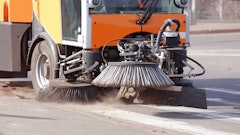Perry Stenzel, salesman for United Rotary Brush Corp., says it's difficult to set a specific number of hours when a broom should be replaced, but he recommends measuring broom filaments to make that determination. "Usually when a broom reaches half its filament length it's time to replace it," Stenzel says.
For example, he says on a 32-in.-diameter broom the core has a diameter of 10 in. while the filaments add an additional 22 in. Once the filaments are worn to 16 in. the broom should be replaced. He says equipment manufacturers and broom manufacturers offer guidelines, and those guidelines should be followed.
He says that regardless of what type of broom you are using all bristles, whether wafers or strips, should be replaced at the same time.
"If a broom is worn to the point where it starts bouncing and doesn't flick anymore, when the bristles get so short and stiff that they don't have that flicking action, you need to replace the broom because otherwise you're just pushing dirt on top of dirt," says Harry Vegter, director of engineering for United Rotary Brush Corp.
Some sweeping equipment enables operators to adjust broom rotation speed, which can extend broom life, and most manufacturers offer guidelines for proper down pressure to maintain a 3 to 4 in. sweeping pattern, meaning the bristles are on the pavement for 3 to 4 in. Stenzel says if the bristles are on more than that then the down pressure is too much, the broom and equipment could be worn out prematurely, and sweeping effectiveness could be reduced.
How Much Down Pressure?
Tom Staab, contracts & product compliance at United Rotary Corp., says the sweeper operator adjusts the down pressure on the broom, creating a 3- to 4-in. wide footprint the width of the sweeper where the broom touches the pavement.
"A 3- or 4-in. footprint from one end of the broom to the other is roughly how much down pressure you want to create," Staab says. "If you have much more pressure than that, you get less flicking action which is needed to get a good sweep. Plus, more pressure wears the broom out more quickly and is harder on the machine."
Wire vs. Poly Bristles
The type of sweeping application plays an important role in selecting the type of bristle for the broom. Filaments are either wire or polypropylene - or a mix of the two. "Wire is very aggressive," says Harry Vegter, United Rotary Corp. director of engineering. "Wire would scratch the surface so contractors use wire brooms or a wire-poly mix primarily on construction sites, temporary road surfaces, and for sweeping after milling." He says cities and towns rarely use wire for basic maintenance road sweeping because wire wears the road surface. "The same is true of parking lot sweeping. Polypropylene is the primary choice overall for city sweeping.
Weigh Shipping Costs
"Wafers and strips are very compact for shipping, so there's a shipping advantage," says Harry Vegter, United Rotary Corp. director of engineering. He says a 66-in. tube broom 36 in. in diameter would require a box almost 6-ft. tall and 36-in. square. "But wafers can be shipped in a box less than half the size of a tube broom, and the same goes for strips which are even more compact than wafers."




![Pavement Awards 2025[main]](https://img.forconstructionpros.com/files/base/acbm/fcp/image/2024/05/PavementAwards_2025_main_.665883e4276e8.png?auto=format%2Ccompress&bg=fff&fill-color=fff&fit=fill&h=100&q=70&w=100)








![Pavement Awards 2025[main]](https://img.forconstructionpros.com/files/base/acbm/fcp/image/2024/05/PavementAwards_2025_main_.665883e4276e8.png?ar=16%3A9&auto=format%2Ccompress&bg=fff&fill-color=fff&fit=fill&h=135&q=70&w=240)







